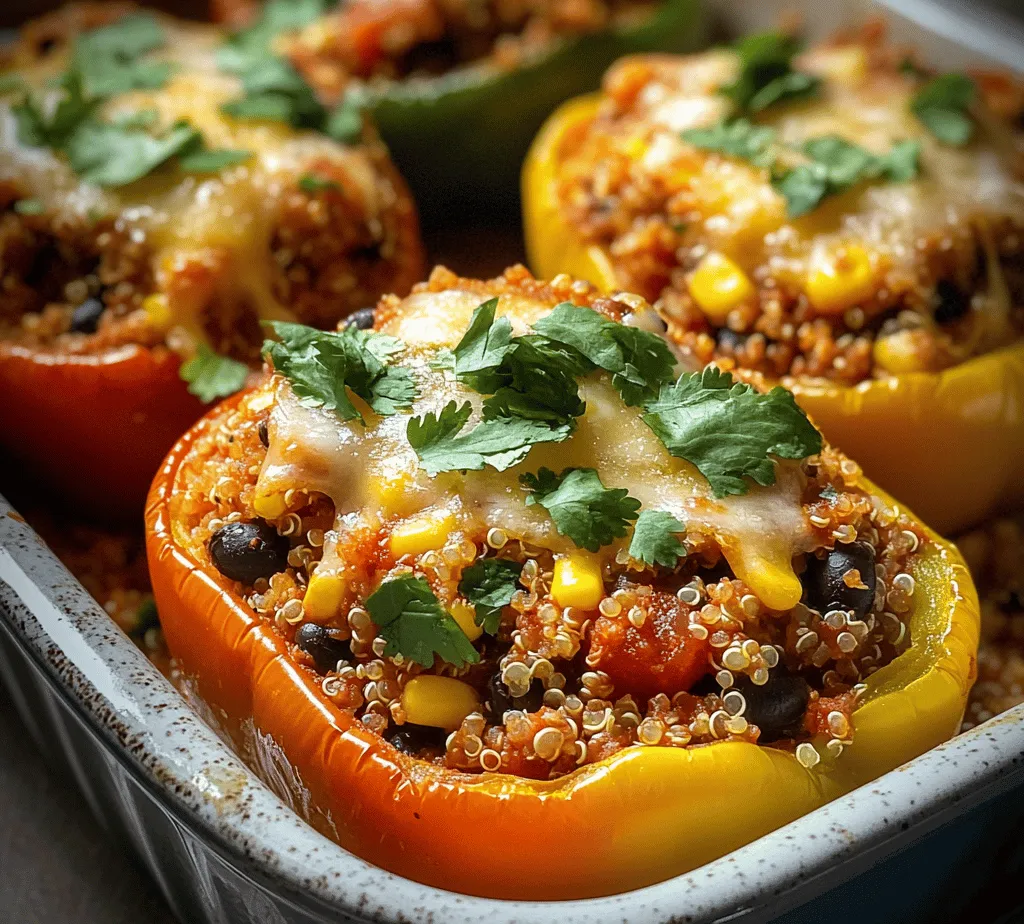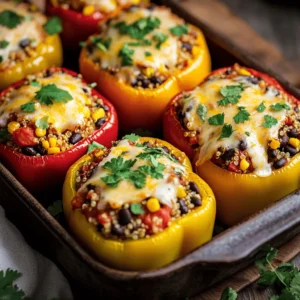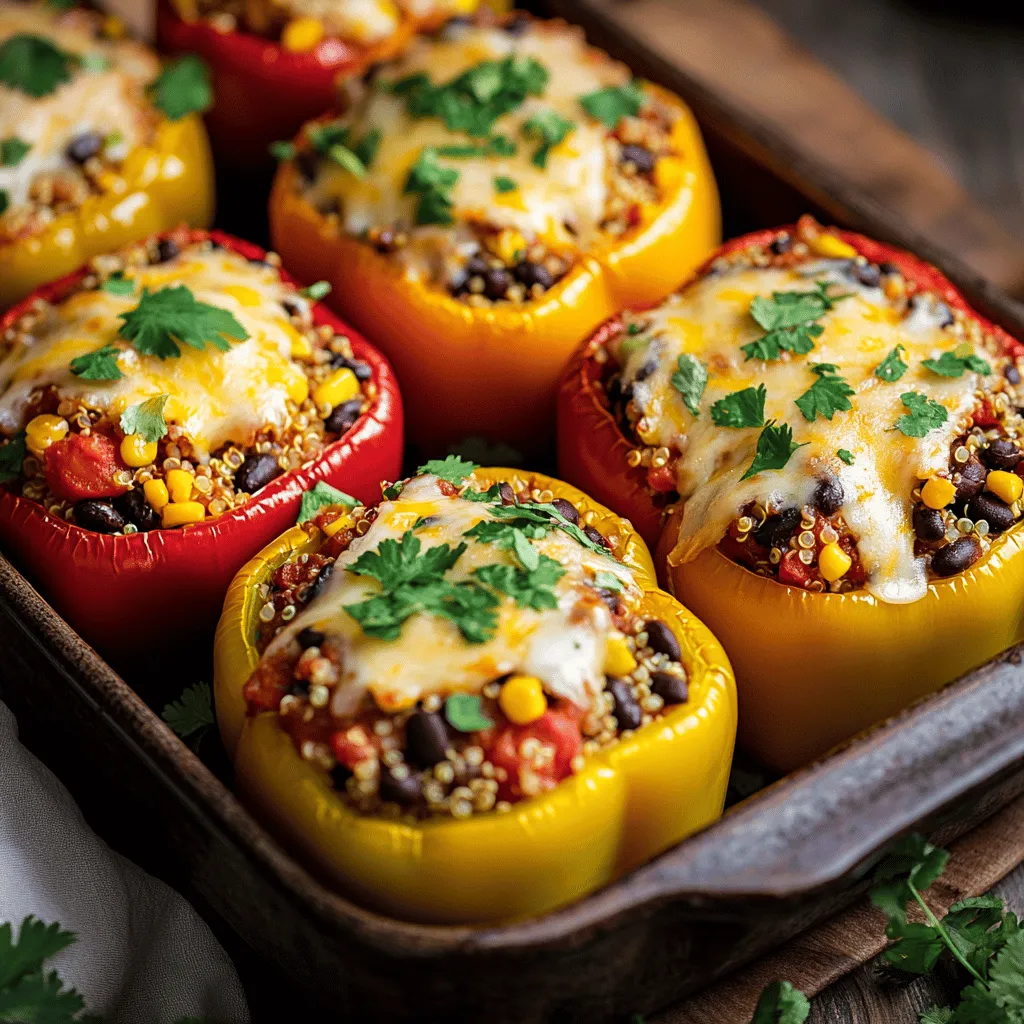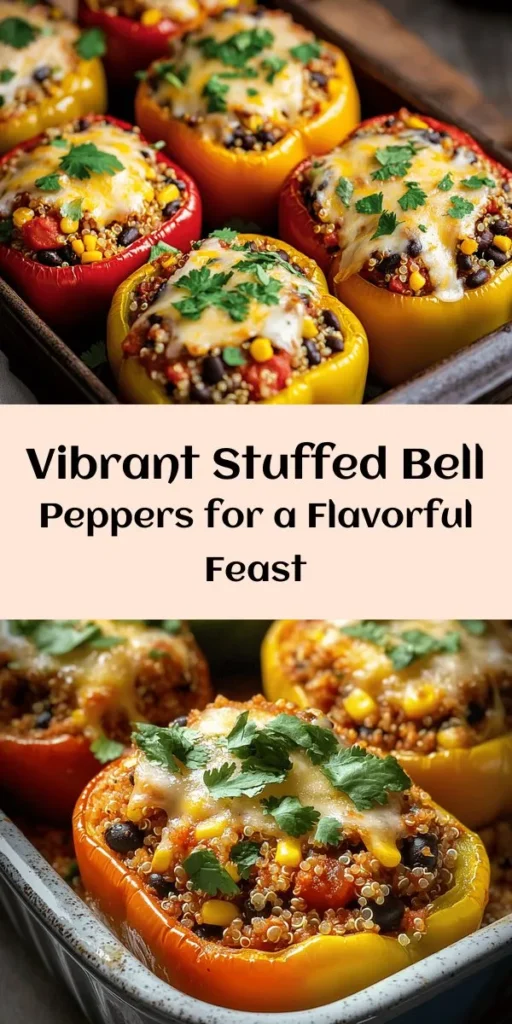Stuffed bell peppers are more than just a dish; they are a delightful explosion of colors, flavors, and nutritional benefits that can transform any meal into a vibrant feast. This versatile recipe showcases bell peppers as edible cups, brimming with a savory filling that can be customized to suit any palate, diet, or occasion. Whether you’re looking for a quick weeknight dinner, a hearty dish for family gatherings, or a health-conscious meal prep option, these colorful flavor bombs are sure to impress.
The Allure of Stuffed Bell Peppers
The origins of stuffed peppers can be traced back to various cultures, each adding its unique twist to this beloved dish. From the Mediterranean to Latin America, stuffed peppers have evolved into countless variations, showcasing regional ingredients and flavors. In Italy, for instance, you might find peppers filled with rice, meat, and tomatoes, while in the Middle East, they may be stuffed with spiced lamb and herbs. The adaptability of stuffed peppers reflects their universal appeal, allowing home cooks to experiment with different fillings and cooking methods.
The concept of stuffing vegetables dates back centuries, making it a timeless culinary tradition. This dish not only provides a way to utilize leftover ingredients but also presents an opportunity to showcase seasonal produce. The vibrant colors of the bell peppers—ranging from rich reds and sunny yellows to deep greens and oranges—make them visually appealing, while the combination of flavors creates a satisfying and wholesome meal.
Ingredients Overview
To create these easy stuffed bell peppers, you will need a selection of wholesome ingredients that contribute both flavor and nutrition. Here’s what you’ll need:
– Bell Peppers: Choose a variety of colors for visual appeal and added nutrients.
– Quinoa or Rice: These grains serve as the base of the stuffing, providing texture and substance.
– Black Beans: Packed with protein and fiber, black beans add heartiness to the filling.
– Corn: Fresh or frozen corn kernels bring sweetness and crunch to the dish.
– Onion and Garlic: Aromatics that enhance the flavor profile of the stuffing.
– Diced Tomatoes: Adds moisture and acidity to balance the flavors.
– Cheese (optional): A sprinkle of cheese on top can create a deliciously melty finish.
– Herbs and Spices: Cumin, paprika, chili powder, and fresh herbs like cilantro or parsley to elevate the dish.
Each ingredient in this recipe plays a crucial role in creating a balanced and flavorful stuffing. The combination of grains, beans, and vegetables not only satisfies hunger but also provides essential nutrients, making these stuffed peppers a well-rounded meal.
Bell Peppers: A Nutritional Powerhouse
Bell peppers are more than just a colorful addition to your plate; they are a powerhouse of nutrition. Rich in vitamins A and C, bell peppers are known for their antioxidant properties, which help combat free radicals in the body. Vitamin C, in particular, supports immune function and skin health, making bell peppers an excellent choice for overall wellness.
The different colors of bell peppers also signify varying levels of nutrients. For instance, red bell peppers contain higher concentrations of beta-carotene and vitamin A compared to their green counterparts. By incorporating a variety of colors into your dish, you not only enhance its visual appeal but also maximize its nutritional benefits.
In addition to vitamins, bell peppers are low in calories and high in water content, making them an ideal ingredient for those looking to maintain a healthy weight. Their crunchy texture adds a satisfying element to dishes, making them a favorite in salads, stir-fries, and, of course, stuffed pepper recipes.
The Role of Quinoa and Rice in the Recipe
One of the key components of stuffed bell peppers is the choice of grain used in the filling. Quinoa and rice are two popular options, each bringing its unique qualities to the dish.
Quinoa is a nutrient-dense grain that is often hailed as a superfood. It is gluten-free, high in protein, and contains all nine essential amino acids, making it a complete protein source. Quinoa is also rich in fiber, which aids in digestion and promotes feelings of fullness. With a slightly nutty flavor and fluffy texture when cooked, quinoa complements the other ingredients well and adds a nutritious boost to your stuffed peppers.
On the other hand, rice is a versatile staple that can be used in various cuisines. It offers a comforting texture and can absorb the flavors of the other ingredients in the stuffing. Brown rice, in particular, is a healthier option, as it retains the bran and germ, providing more fiber and nutrients compared to white rice. However, white rice can be used for a softer texture and quicker cooking time.
When choosing between quinoa and rice, consider your dietary preferences and nutritional goals. Both options can create delicious stuffed peppers, so feel free to experiment with different grains to find your favorite combination.
Beans and Corn: Adding Fiber and Protein
Incorporating black beans and corn into the stuffing elevates the nutritional profile of your stuffed peppers. Black beans are an excellent source of plant-based protein, making them a great choice for vegetarians and vegans. They are also rich in fiber, which aids in digestion and helps regulate blood sugar levels. This makes black beans a perfect addition for those looking to maintain steady energy levels throughout the day.
Furthermore, black beans are packed with essential nutrients, including folate, iron, and magnesium. Folate is crucial for cellular function and tissue growth, making it particularly important for pregnant women. The iron in black beans supports oxygen transport in the blood, while magnesium contributes to muscle and nerve function.
Corn, whether fresh or frozen, adds a touch of sweetness and crunch to the stuffing. It is a good source of carbohydrates, providing a quick source of energy. Corn also contains antioxidants and vitamins, such as B vitamins and vitamin C. The combination of black beans and corn creates a satisfying balance of protein, fiber, and flavor, making these stuffed peppers a filling and nutritious meal option.
Herbs and Spices: The Flavor Enhancers
To truly elevate your stuffed bell peppers, the addition of herbs and spices is essential. Ingredients like cumin, paprika, and chili powder not only contribute depth and warmth to the dish but also offer potential health benefits.
Cumin is known for its distinctive earthy flavor and is often used in various cuisines around the world. It is rich in iron and has been associated with digestive health. Adding cumin to your stuffing can enhance its flavor profile while providing nutritional benefits.
Paprika, derived from dried and ground peppers, adds a gentle sweetness and vibrant color to the dish. It is high in antioxidants and may have anti-inflammatory properties, making it a healthy addition to your meal.
Chili powder, a blend of different spices, adds a kick to the stuffing. Depending on the variety, it can range from mild to hot, so you can adjust the amount to suit your taste preferences. The heat from chili powder can also increase metabolism, providing an extra boost to your meal.
In addition to these spices, fresh herbs such as cilantro or parsley can be sprinkled on top before serving, adding a burst of freshness and enhancing the overall flavor of the dish. The right combination of herbs and spices will transform your stuffed peppers into a culinary delight that tantalizes the taste buds.
Step-by-Step Instructions for Perfect Stuffed Peppers
Now that we’ve explored the vibrant ingredients that make up our easy stuffed bell peppers, it’s time to dive into the step-by-step instructions for creating these flavorful dishes. Follow these simple guidelines to ensure your stuffed peppers turn out perfectly:
1. Preheat the Oven: Begin by preheating your oven to 375°F (190°C). This allows for even cooking once the stuffed peppers are ready to go into the oven.
2. Prepare the Bell Peppers: Choose your favorite bell peppers, and carefully slice off the tops. Remove the seeds and membranes inside to create a hollow space for the filling. You can also trim the bottoms slightly if needed, ensuring they stand upright while baking.
3. Cook the Grains: Prepare your quinoa or rice according to package instructions. If using quinoa, rinse it under cold water before cooking to remove any bitterness. Cook until fluffy and set aside.
4. Sauté the Aromatics: In a large skillet, heat a drizzle of olive oil over medium heat. Add diced onions and minced garlic, sautéing until they are soft and fragrant, about 3-5 minutes.
5. Mix the Filling: In a large bowl, combine the cooked quinoa or rice, sautéed onions and garlic, black beans, corn, diced tomatoes, and your chosen spices. Mix well until all ingredients are evenly combined.
6. Stuff the Peppers: Spoon the filling into each bell pepper, packing it in gently. Leave a little space at the top for the cheese if you’re using it.
7. Bake the Peppers: Arrange the stuffed peppers upright in a baking dish. If desired, sprinkle cheese on top of each pepper. Cover the dish with aluminum foil and bake for 25-30 minutes, then remove the foil and bake for an additional 10 minutes, until the peppers are tender and the cheese is bubbly.
These stuffed bell peppers are not only a feast for the eyes but also a wholesome, nutritious meal that can fit into any busy schedule. Their versatility allows for easy customization, making them a staple in any home cook’s repertoire. The combination of colorful ingredients, vibrant flavors, and health benefits makes these easy stuffed bell peppers a perfect choice for any occasion, from weeknight dinners to special celebrations.

Prepping the Bell Peppers
To create visually appealing and delicious stuffed bell peppers, the first step is preparing the peppers themselves. Choose a mix of colorful bell peppers—red, yellow, green, and orange—not only for their vibrant appearance but also for their distinct flavors. Begin by washing the peppers thoroughly under cold water to remove any dirt or residues.
Once cleaned, slice the tops off each pepper, about half an inch from the top. This allows enough space to fill them while still maintaining their structure. Use a sharp knife to carefully cut around the stem and remove it along with the seeds and white membranes inside, which can add bitterness to the dish. For a cleaner cut and a better presentation, consider using a small paring knife to help guide your cuts. After cleaning, give the peppers a gentle shake to remove any remaining seeds.
The way you prep your bell peppers can significantly impact both the texture and the final presentation of your dish. If you prefer them slightly tender, you can blanch them in boiling water for 2-3 minutes before stuffing. This step softens the peppers, making them easier to eat and enhancing their vibrant color. However, if you want the peppers to retain a firmer bite, skip this step and proceed with the filling.
Cooking the Filling to Perfection
Now that your bell peppers are ready, it’s time to create the flavorful filling. Start by heating a tablespoon of olive oil in a large skillet over medium heat. Add finely chopped onions and sauté them until they become translucent, which should take about 4-5 minutes. The key here is to develop a sweet, caramelized flavor, which will provide a solid foundation for your filling.
Next, add minced garlic to the skillet and sauté for an additional minute, just until fragrant. Be careful not to burn the garlic, as it can turn bitter. Now, incorporate your choice of cooked grains, such as quinoa or rice, and any additional vegetables you’d like to include. Stir the mixture well, allowing the ingredients to meld together. Season with salt, pepper, and a pinch of your favorite herbs or spices to enhance the overall flavor profile.
If you’re adding proteins like cooked ground turkey, beef, or beans, now is the time to mix them in. Ensure everything is heated through, as this not only helps the flavors to combine but also preps the filling for a seamless stuffing experience. Once everything is cooked, remove the skillet from the heat and stir in shredded cheese, which will add creaminess and help bind the filling together.
Filling and Baking the Peppers
With your filling complete, it’s time to stuff those beautifully prepped peppers. Using a spoon, gently fill each pepper with the mixture, pressing down lightly to ensure they’re filled to the brim. Avoid overstuffing, as it can lead to spilling during baking. If you’ve opted to add more cheese on top, sprinkle it generously over each filled pepper.
To achieve a perfect cheese melt and maintain the peppers’ structure while baking, arrange them upright in a baking dish. If they wobble, you can slice a small amount off the bottom to create a flat surface. Pour a small amount of vegetable broth or water into the bottom of the baking dish—this will create steam during the baking process, helping the peppers cook through more evenly.
Cover the dish with aluminum foil and place it in a preheated oven at 375°F (190°C). Bake for about 25-30 minutes. After this initial baking time, remove the foil and continue baking for another 10-15 minutes until the cheese is bubbly and golden brown, and the peppers are tender yet still hold their shape.
Garnishing for Presentation
Once your stuffed peppers are out of the oven, let them cool for a few minutes before garnishing. Fresh herbs can elevate the visual appeal and flavor complexity of your dish. Finely chop fresh cilantro, parsley, or basil and sprinkle them over the top of the peppers. This not only adds a pop of color but also a refreshing herbal note that complements the richness of the filling.
Consider adding a dollop of sour cream or a drizzle of balsamic glaze for an extra layer of flavor and a beautiful presentation. These garnishes will entice your guests and enhance the overall dining experience.
Serving Suggestions for Stuffed Bell Peppers
Stuffed bell peppers are versatile and can be served in various ways to create a well-rounded meal. Consider pairing them with a simple side salad for a fresh crunch. A mixed greens salad with a light vinaigrette works wonderfully to balance the richness of the peppers.
For a heartier option, serve the peppers alongside garlic bread or a warm grain bowl. You can also offer dipping sauces, such as salsa, guacamole, or tzatziki, to provide additional flavor dimensions that guests can customize to their taste.
If you’re looking to make this dish a centerpiece for a special occasion, consider plating the stuffed peppers on a large serving platter, garnished with extra herbs and accompanied by a colorful array of sides. This presentation not only looks inviting but also encourages guests to share and enjoy the meal together.
Storage and Reheating Tips
If you find yourself with leftovers, stuffed bell peppers store quite well. Allow them to cool completely before transferring them to an airtight container. They can be stored in the refrigerator for up to 4-5 days. To reheat, place them in a microwave or oven until heated through—if using the oven, cover with foil to prevent the cheese from over-browning.
For long-term storage, stuffed peppers can be frozen. Wrap each pepper individually in plastic wrap and place them in a freezer-safe container. They can last up to three months in the freezer. When ready to eat, thaw them overnight in the refrigerator and reheat as desired.
This dish is versatile enough to transform into new meals. For instance, you can slice the peppers and mix them into a salad or use the filling as a topping for baked potatoes or nachos.
Conclusion: Enjoying Your Colorful Flavor Bombs
Creating stuffed bell peppers is not only an enjoyable cooking experience but also a delightful way to bring family and friends together. These vibrant, flavor-packed dishes are a blank canvas for your culinary creativity—experiment with different fillings, spices, and garnishes to suit your taste.
By following this guide, you’re equipped to replicate this colorful dish in your kitchen, bringing joy to your table with every bite. Remember to embrace the process, invite your loved ones to join in, and make the stuffed bell peppers a staple in your culinary repertoire. Enjoy the satisfaction of crafting these colorful flavor bombs and the smiles they bring to those who share in the meal.



